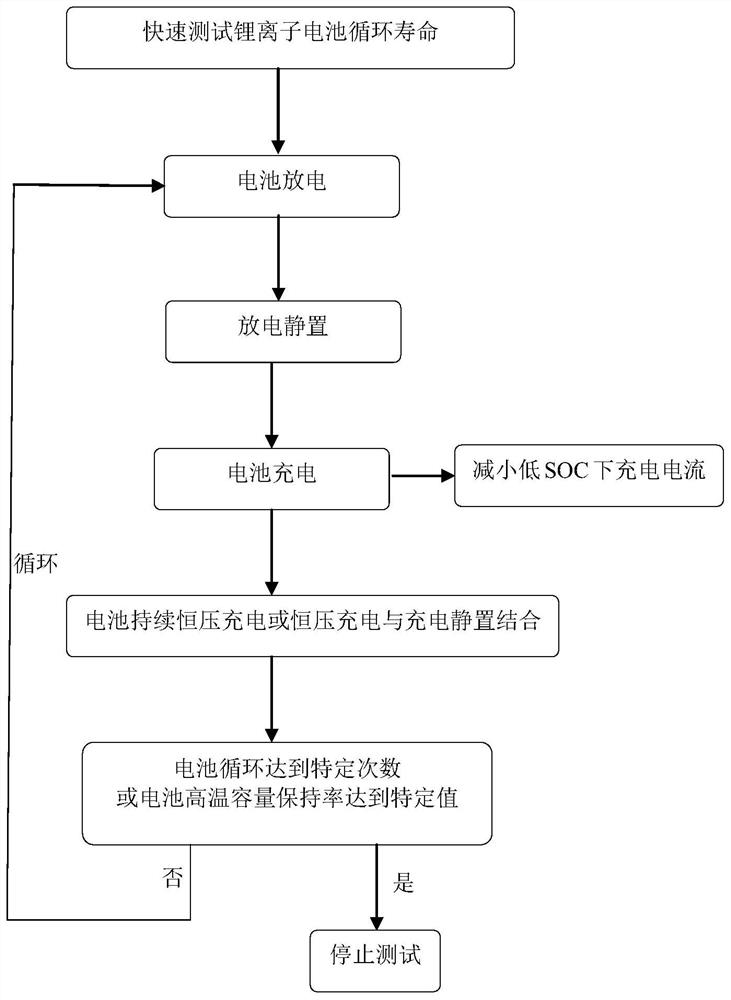Method for rapidly testing cycle life of lithium ion battery
A lithium-ion battery, cycle life technology, applied in the direction of measuring electricity, measuring electrical variables, measuring devices, etc., can solve the problem of long cycle life testing time, so as to facilitate rapid development, accelerate reaction consumption, and shorten the time required for testing Effect
- Summary
- Abstract
- Description
- Claims
- Application Information
AI Technical Summary
Problems solved by technology
Method used
Image
Examples
preparation example Construction
[0060] The preparation method of the present invention will be further described in detail in conjunction with specific examples below. It should be understood that the following examples are only for illustrating and explaining the present invention, and should not be construed as limiting the protection scope of the present invention. All technologies realized based on the above contents of the present invention are covered within the scope of protection intended by the present invention.
[0061] The experimental methods used in the following examples are conventional methods unless otherwise specified; the reagents and materials used in the following examples can be obtained from commercial sources unless otherwise specified.
Embodiment 1
[0063] The lithium-ion battery is produced according to the conventional manufacturing process, the positive electrode active material is lithium cobaltate, the negative electrode active material is graphite, and the battery design capacity is 4000mAh. The known charging upper limit voltage of the lithium-ion battery is 4.35V, the known discharging lower limit voltage is 3.0V, and the known rate in the constant current charging process is 0.7C.
[0064] Place the lithium-ion battery in an environment of 45°C, and the test process is as follows:
[0065] Discharge the fully charged lithium-ion battery. The discharge process is to discharge to 3.0V at a discharge rate of 0.5C, and then discharge and stand for 10 minutes;
[0066] To charge the discharged lithium-ion battery, first use 0.1C to charge to 80% of the design capacity, then charge to 4.35V at a rate of 0.7C, and then perform constant voltage charging at 4.35V to adjust the time used for constant voltage charging , so...
Embodiment 2
[0068] The lithium ion battery is the same as in Example 1, and the test method is different from Example 1.
[0069] The test method of this embodiment is as follows:
[0070] Place the lithium-ion battery in an environment of 50°C, and the test process is as follows:
[0071] Discharge the fully charged lithium-ion battery. The discharge process is to discharge to 3.0V at a discharge rate of 0.5C, and then discharge and stand for 10 minutes;
[0072] To charge the discharged lithium-ion battery, first use 0.1C to charge to 40% of the design capacity, then use 0.3C to charge to 70% of the design capacity, then use 0.7C to charge to 4.35V, and then start charging at 4.35V Carry out constant voltage charging, adjust the time used for constant voltage charging, so that the total time of each cycle is 24 hours, and record the corresponding number of cycles when the capacity retention rate reaches 90%. The results are shown in Table 1.
PUM
 Login to View More
Login to View More Abstract
Description
Claims
Application Information
 Login to View More
Login to View More - R&D
- Intellectual Property
- Life Sciences
- Materials
- Tech Scout
- Unparalleled Data Quality
- Higher Quality Content
- 60% Fewer Hallucinations
Browse by: Latest US Patents, China's latest patents, Technical Efficacy Thesaurus, Application Domain, Technology Topic, Popular Technical Reports.
© 2025 PatSnap. All rights reserved.Legal|Privacy policy|Modern Slavery Act Transparency Statement|Sitemap|About US| Contact US: help@patsnap.com

